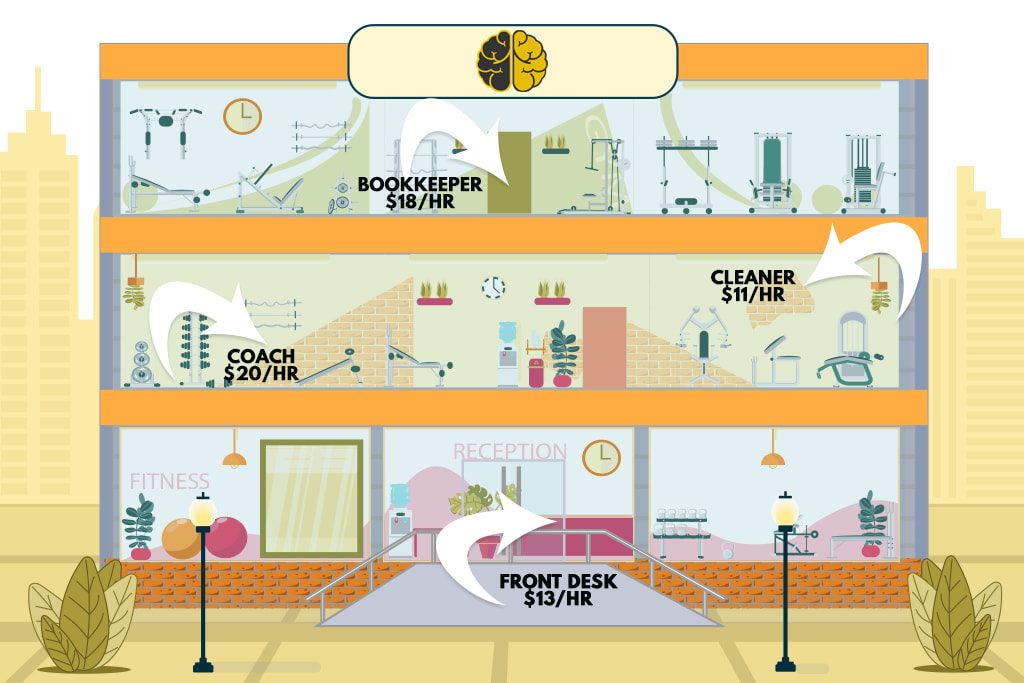How do you invest your time better?
How can you work on marketing when the floor needs to be scrubbed?
Your job as entrepreneur is to invest your time in the highest-value roles. That means removing less-valuable things from your plate. But most entrepreneurs don’t do this well.
They say things like:
“No one can do this like me!”
“It’s faster to just do this myself!”
“I can’t afford any screw-ups!”
“No one cares as much as I do!
I’ve been there. The tug-of-war between “I know I should delegate!” and “I can’t turn my baby over to my staff!” is an internal battle between logic and emotion. Luckily, that’s why we’re called Two-Brain Business: We work with both.
In the previous post, I had you calculate your effective hourly rate (EHR).
Now your job is to figure out the value of the work you’re doing in your gym, then grow your business by working on higher-value tasks.
1. Break Down Your Day by the Hats You Wear
If you were to duplicate yourself into 12 clones, and each clone could only do one job all day, what would those jobs be?
Cashier? Maker of the doughnuts? Purchaser or supplies? Decorator? Cleaner?
Make a list. We call these “roles.”
2. Program Your Clones
Make a step-by-step list of everything you do in each role.
For example, the cashier is responsible for entering client sales correctly, processing refunds, collecting money, closing the batch at the end of the night, balancing receipts with collected funds at the end of the shift (and end of day), depositing funds at the bank, and so on.
Make the checklist as simple as possible. We call these “tasks.”
3. Assign an Hourly Value to Each Role
Front Desk staff—$13 per hour?
Bookkeeping—$18 per hour?
Coach—$20 per hour?
Cleaner—$11 per hour?
We call these costs “replacement value.” You will hire valuable people to replace you in each role eventually. And you will pay them what the role is worth.
4. Do a Time Valuation
How much time do you spend in each role? Record your total time spent (in hours) for one week.
For example:
- Front Desk—10 hours
- Coach—20 hours
- Bookkeeping—3 hours
- Cleaner—5 hours
Multiply total time by the replacement value of each role.
- Front Desk—10 hours x $13 per hour = $130 replacement value
- Coach—20 hours x $20 per hour = $400 replacement value
- Cleaner—5 hours x $11 per hour = $55 replacement value
5. Replace Yourself
From your list of replacement values, find the lowest. Hire a person to fill that role.
Give the person a three-month contract that clearly spells out the role and every associated task.
In other words, provide a checklist.
Buy yourself a window of time to fill with higher-value work.
6. Reinvest Your Time
Here’s the critical part: You, the owner, must reinvest the time you save by working in a higher-value role.
We call this “climbing the value ladder.”
If you bought yourself five hours by hiring a cleaner, you must show a positive return on that purchase.
You can either replace the coach for five hours, saving yourself $100 (five hours x $20) or you can jump a few rungs up the ladder and spend time in a new role, like marketing.
Key: don’t hire anyone until you know exactly how you’ll invest your new “free” time.
7. Evaluate Staff Performance
After a month, evaluate each person and assign a scale from 1 to 10 for each task.
Then review performance with the staff member. What can he or she improve?
Now review your performance in your new role. What can you improve Are you seeing a positive return?
8. Repeat the Process
Repeat steps 5, 6 and 7 for each role below your EHR. Buy yourself more time. Climb to the next step. Measure your return on time.
9. Recalculate and Hire
Every quarter, recalculate your EHR and hire for more roles.
Building a Real Business
Most entrepreneurs never build a business: They buy themselves a job instead.
But if they want to scale, be able to sell their business someday or just take a holiday, they must replace themselves in all roles eventually.
This is the directive approach we teach entrepreneurs in the Two-Brain Business RampUp program. It’s virtually risk-free and far less scary than the usual “ready, fire, aim” approach to hiring.
This is the secret to entrepreneurship that Michael Gerber, John C. Maxwell and dozens of others write about: moving from “doing the job” to “owning the business.”
You don’t need to hire a full-time employee to free up time. You can move from role to role incrementally.
Keep in mind:
- You must replace yourself in each role completely. That means identifying the tasks to be done, codifying those tasks, setting a “gold standard” for each task and then evaluating success.
- You must have a clear plan for the higher-value work you’ll do. Otherwise you’ll be sucked back into minutiae.
- Finally, even if you don’t have a great idea right now, you need to be ready for the next one. A huge reason why my companies grow so fast is that I don’t have a permanent role in any of them; I can replace myself quickly when a new opportunity comes along.
This is how you give yourself a promotion as an entrepreneur.
If you want to grow your business faster, spend more time on roles that are worth more than your current EHR.
If you want your business to go backward, fire the cleaner and mop the floors yourself. You can’t cut your way to growth.

